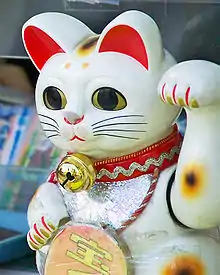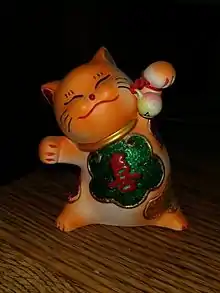Maneki-neko
The Maneki-neko (招き猫, lit. 'beckoning cat') is a common Japanese figurine which is often believed to bring good luck to the owner. In modern times, they are usually made of ceramic or plastic. The figurine depicts a cat, traditionally a calico Japanese Bobtail, with a paw raised in a Japanese beckoning gesture. The figurines are often displayed in shops, restaurants, pachinko parlors, dry cleaners, laundromats, bars, casinos, hotels, nightclubs, and other businesses, generally near the entrance. Some Maneki-neko are equipped with a mechanical paw which slowly moves back and forth.

Maneki-neko come in different colors and styles and vary in degrees of detail. Common colors are white, black, and gold. In addition to statues, Maneki-neko can be found in the form of keychains, piggy banks, air fresheners, pots, and numerous other media. Maneki-neko are sometimes referred to simply as "lucky cats".
Common features

Maneki-neko are traditionally depicted seated, holding a koban coin, with one paw raised in a beckoning gesture. To some Westerners (Italians and Spaniards are notable exceptions) it may seem as if the Maneki-neko is waving rather than beckoning.[1][2] This is due to the difference in gestures and body language recognized by some Westerners and the Japanese. The Japanese beckoning gesture is made by holding up the hand, palm down, and repeatedly folding the fingers down and back, thus the cat's appearance. Some Maneki-neko made specifically for some Western markets will have the cat's paw facing upwards, in a beckoning gesture that is more familiar to most Westerners.[3]
Maneki-neko can be found with either the right or left paw raised (and sometimes both). The significance of the right and left raised paw differs with time and place.[4] A statue with the left paw raised is to get more customers, while the right paw raised is to get more money. Hence it is also said that the one with left paw is for business and the right is for home.[5]
Some Maneki-neko feature battery- or solar-powered moving arms endlessly engaged in the beckoning gesture.
Colors
Originally, Maneki-neko were white, but over the years with the combination of Feng Shui, different colour variations were born. The original white colour is to get good luck and overall good fortune, while black is to ward off evil, red is for good health, yellow or gold is for wealth, and pink is for romance.[5]

Composition
Antique examples of Maneki-neko may be made of carved wood, stone and metal, handmade porcelain or cast iron.[4]
Origins

History



It is commonly believed that Maneki-neko originated in Tokyo (then named Edo), while some insist it was Kyoto.[4] Maneki-neko first appeared during the later part of the Edo period in Japan.[4] The earliest records of Maneki-neko appear in the Bukō nenpyō's (a chronology of Edo) entry dated 1852. Utagawa Hiroshige's ukiyo-e "Joruri-machi Hanka no zu," painted also in 1852, depicts the Marushime-neko, a variation of Maneki-neko, being sold at Senso temple, Tokyo. In 1876, during the Meiji era, it was mentioned in a newspaper article, and there is evidence that kimono-clad Maneki-neko were distributed at a shrine in Osaka during this time. A 1902 advertisement for Maneki-neko indicates that by the turn of the century they were popular.[7] Beyond this the exact origins of Maneki-neko are uncertain.
Some have noted the similarities between the Maneki-neko's gesture and that of a cat washing its face. There is a Japanese belief that a cat washing its face means a visitor will soon arrive. This belief may in turn be related to an even older Chinese proverb that states that if a cat washes its face, it will rain. Thus, it is possible a belief arose that a figure of a cat washing its face would bring in customers. In his Miscellaneous Morsels from Youyang, China's Tang Dynasty author Duan Chengshi (803?–863) wrote: "If a cat raises its paw over the ears and washes its face, then patrons will come". Statues of cats washing their ears (though very different in style to Maneki-neko) have been found as early as the Northern Wei Dynasty (386 to 534 AD).[8]
There are many legends about the birth of Maneki-neko, of which the most popular is the legend of Gōtoku-ji temple. In the 17th century, a poor monk lived in the small Zen temple in Setagaya, Tokyo. Although his life was very difficult, he shared his own meager meals with his pet cat which strayed into the temple. One day, a lord samurai Ii Naotaka of the Hikone Domain district was on his way to hunt when suddenly a storm came, and he had to seek safety under a big tree near the temple. Sheltering there, he noticed the cat, raising one paw as if waving him to the temple. Curious, he left his cover and headed for the temple to have a better look at the strange cat. As he did so, a lightning bolt destroyed the tree beneath which he had just been standing. Naotaka was so grateful, he became the patron of the temple, repaired it to become more spacious. When the cat died, he was buried in a special graveyard for cats. In the temple, a statue of Maneki-neko was made to commemorate this special cat that has been revered ever since.
Alternatively, according to a folktale the operator of an impoverished shop (or inn, tavern, temple, etc.) took in a starving stray cat despite barely having enough to feed himself. In gratitude, the cat sat in the front of the store beckoning customers, thus bringing prosperity as a reward to the charitable proprietor. Ever after, the "beckoning cat" has been a symbol of good luck for small business owners.[4]
In popular culture

Modern Japanese superstition suggests that keeping a talisman of good fortune, such as the Maneki-neko, in bedrooms and places of study will bring about favorable results and life successes.
Because of its popularity in Chinese and Vietnamese communities (including Chinatowns in the United States)[4] the Maneki-neko is frequently mistaken for being Chinese in origin rather than Japanese, and is incorrectly referred to as a "Chinese lucky cat"[4] or jīnmāo ("golden cat"). This cat is also prevalent in China domestically, and is usually referred to as simplified Chinese: 招财猫; traditional Chinese: 招財貓; pinyin: zhāocáimāo.
A Pokémon named Meowth is based on Maneki-neko.[9]
Netta performed her song "Toy" in front of two walls full of Maneki-neko at the Eurovision Song Contest 2018. She won the competition after collecting 529 points at the final.[10]
A Maneki-neko is also seen in the production logo for Funimation.
Notes
- Calero, Henry H. (2005). The Power of Nonverbal Communication: How You Act is More Important Than what You Say. Aberdeen, Washington: Silver Lake Publishing. p. 116. ISBN 978-1-56343-788-5.
- Wibbeke, E. S. "Gestures around the World". Globalbusinessleadership.com. Archived from the original on 11 March 2017. Retrieved 4 December 2012.
- Mishima, Shizuko. "Manekineko: Japanese Lucky Cats". Japan Travel. About.com. Archived from the original on 28 April 2012. Retrieved 3 August 2009.
- Pate, Alan (2008). "Maneki Neko: Feline Fact & Fiction". Daruma Magazine. Amagasaki, Japan: Takeguchi Momoko. Archived from the original on 14 March 2013. Retrieved 30 December 2012.
- "招き猫の色やあげている手の違いなど知られざる意味を一挙解説!" [Commentary on unknown meanings such as the color of the beckoning cat and the difference of raising hands]. nekochan.jp (in Japanese). 27 March 2019. Retrieved 18 April 2019.
- Gotokuji Temple: Tokyo's "Lucky Cat" Temple
- Schumacher, Mark. "Maneki Neko: The Lucky Beckoning Cat". A to Z Photo Dictionary of Japanese Buddhist Statuary. Retrieved 3 August 2009.
- "1600年前北魏雕像群中現招財貓形象(圖)" [The image of the lucky cat in the statues of the Northern Wei Dynasty 1600 years ago (photo)]. people.com.cn (in Chinese). 10 June 2014. Retrieved 27 April 2019.
- "On the Origin of Species: Meowth". Bulbanews. 19 July 2010. Retrieved 27 January 2017.
- "63 years of Eurovision". Eurovision Song Contest. Archived from the original on 21 June 2018. Retrieved 21 June 2018.
References
| Wikimedia Commons has media related to Maneki neko. |
- Dale-Green, Patricia (1963). The Cult of the Cat. Boston: Houghton Mifflin. ISBN 978-0517175002.
- Daniels, Inge Maria (2003). "Scooping, raking, beckoning luck: luck, agency and the interdependence of people and things in Japan". Royal Anthropological Institute. 9 (4): 619–638. doi:10.1111/j.1467-9655.2003.00166.x.
- Masuda, Koh, ed. (1991). Kenkyusha's New Japanese-English Dictionary (4 ed.). Tokyo: Kenkyusha Limited. ISBN 4767420253.
- Pate, Alan Scott (2011). Maneki Neko. San Diego: Mingei International Museum. ISBN 9780914155256.
- Wellman, Laurel (2004). Lucky Cat: He Brings You Good Luck. San Francisco: Chronicle Books. ISBN 0-8118-4121-9.